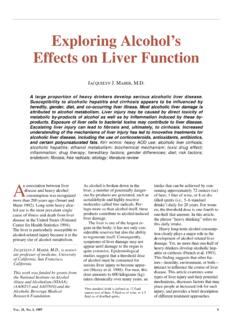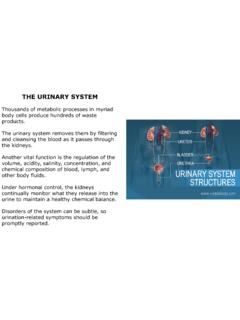Transcription of Histology of Normal Tissues
1 SMGr up Histology of Normal Tissues Ana-Maria Enciu1,2*#, Cristina Mariana Niculite1,2# and Ancuta Augustina Gheorghisean Galateanu1,3#. 1. Department of Biology, Carol Davila University of Medicine and Pharmacy, Romania 2. Department of Biology, Victor Babes National Institute of Pathology, Romania 3. Department of Morphological Sciences, CI Parhon National Institute of Endocrinology, Romania #. authors contributed equally to this work *Corresponding author: Ana-Maria Enciu, Carol Davila University of Medicine and Pharmacy, Bucharest, Romania, Tel: +4021-3192734, Email: Published Date: December 26, 2016.
2 INTRODUCTION. Histology is a word deriving from old greek (histos- cloth, tissue and logos- word, speech), meaning science of Tissues . It provides the researcher with microscopic details of Tissues and organs of the human body. As a science, it started with Robert Hooke's coining of the term cell , back in 1665 and continued with Antonie van Leeuwenhoek's attempts towards developing staining techniques. It took almost a century of trial-and-error for stainings to become a serious research branch of organic chemistry, but by the end of the 1800s, Camillo Golgi and Ramon y Cajal, using specific protocols forsilver staining, had reached another milestone in Histology study by detailing the structure of the central nervous system, which was awarded the Nobel Prize for Medicine in 1906.
3 Histopathology | 1. Copyright Enciu book chapter is open access distributed under the Creative Commons Attribution International License, which allows users to download, copy and build upon published articles even for commercial purposes, as long as the author and publisher are properly credited. In the modern era, Histology is the tool for accessing a specific knowledge of the microscopic organization of the organs, microscopic anatomy, which is essential to understand the histopathology for a possible diagnosis.. The study of Normal Tissues reached a consensus widely accepted and published in reputed textbooks, which continue to update the information each year with more and more data from molecular biology and genetics.
4 Discovery of adult stem cells, their niches and their rapidly dividing precursors changed the classical view of Tissues as masses of similar or identical cells that perform the same function. However, the fundamental histological structure describing general organization of Tissues changed very little during the last half of century, giving pathologists strong grounds for diagnosisand research. Based on morphological and functional characteristics, classic Histology describes only four types of fundamental Tissues : epithelial, connective, muscle and nervous.
5 These four classes respect the general pattern of organization of a tissue, a cellular compartment and an extracellular matrix, the latter comprising fibers and ground substance. This chapter aims at offering basic knowledge on microscopy study of Normal organization of fundamental Tissues of the human body, which can be further used as a starting point for a better understanding of pathology. EPITHELIAL TISSUE. Epithelial tissue is widely distributed in the human body, forming the covering layer of the skin, as well as covering layers of inner tubular organs, including blood vessels.
6 It also forms glands with endocrine and exocrine secretion. It is characterized by a rapid turnover, rich innervation and the lack of vascularization. Cells are nourished via diffusion of metabolites and oxygen from the blood vessels of the underlying connective tissue. The cellular compartment is composed of compact cell masses comprising cells with different forms, which are closely joined to each other by cell junctions. The epithelial cells show polarity, with an apical domain towards the free surface of the tissue and a basolateral domain, facing the extracellular matrix.
7 The extracellular compartment is weakly represented. All epithelia are attached to adjacent connective tissue by an extracellular supporting structure rich in glycoproteins and proteoglycans, produced by both epithelial cells and underlying connective tissue cells, called basement membrane. Based on their function, epithelia are classified into covering epithelia, glandular epithelia and sensory epithelia. Furthermore, covering and glandular epithelia comprise several different types, depending on morphological characteristics. Histopathology | 2.
8 Copyright Enciu book chapter is open access distributed under the Creative Commons Attribution International License, which allows users to download, copy and build upon published articles even for commercial purposes, as long as the author and publisher are properly credited. Covering Epithelia Covering epithelia are classified as simple or stratified epithelia according to the number of cell layers. The morphology of the cells may be squamous (flat), cuboidal and columnar. The nucleus of cells has also a different morphology, depending of the type of cell, being a strong diagnostic criterion: for squamous cells in cross section, the nucleus is flat, for cuboidal cells it is round and centrally located, and for columnar cells it is elongated, with the long axis parallel to the long axis of the cell.
9 For the stratified epithelium, the cells that form the top layer give the name of the epithelium. Simple squamous epitheliumis composed of a single row of flattened cells with flattened nuclei. This epithelium is found in the wall of blood and lymph vessels, where the epithelium is called endothelium, in serous membranes that line the body cavities (pleura, pericardia, peritoneum). where the epithelium is called mesothelium, in the parietal layer of Bowman's capsule and pulmonary alveoli of the lung. Simple cuboidal epitheliumis formed of a single row of cuboidal cells with round nuclei.
10 This epithelium lines some uriniferous tubules and small ducts of exocrine glands. Simple columnar epithelium contains a row of columnar cells with elongated nuclei. The cells of this type of epithelium may present microvilli or cilia. It is found in the stomach, small intestine (with microvilli forming the brush border), colon, gallbladder, and fallopian tubes (with cilia). Figure 1: Simple epithelia. Stratified squamous keratinized epithelium comprises several layers with cells of various forms: cuboidal or columnar in the basal layer, polygonal in the intermediate layer, and flat at the surface.







